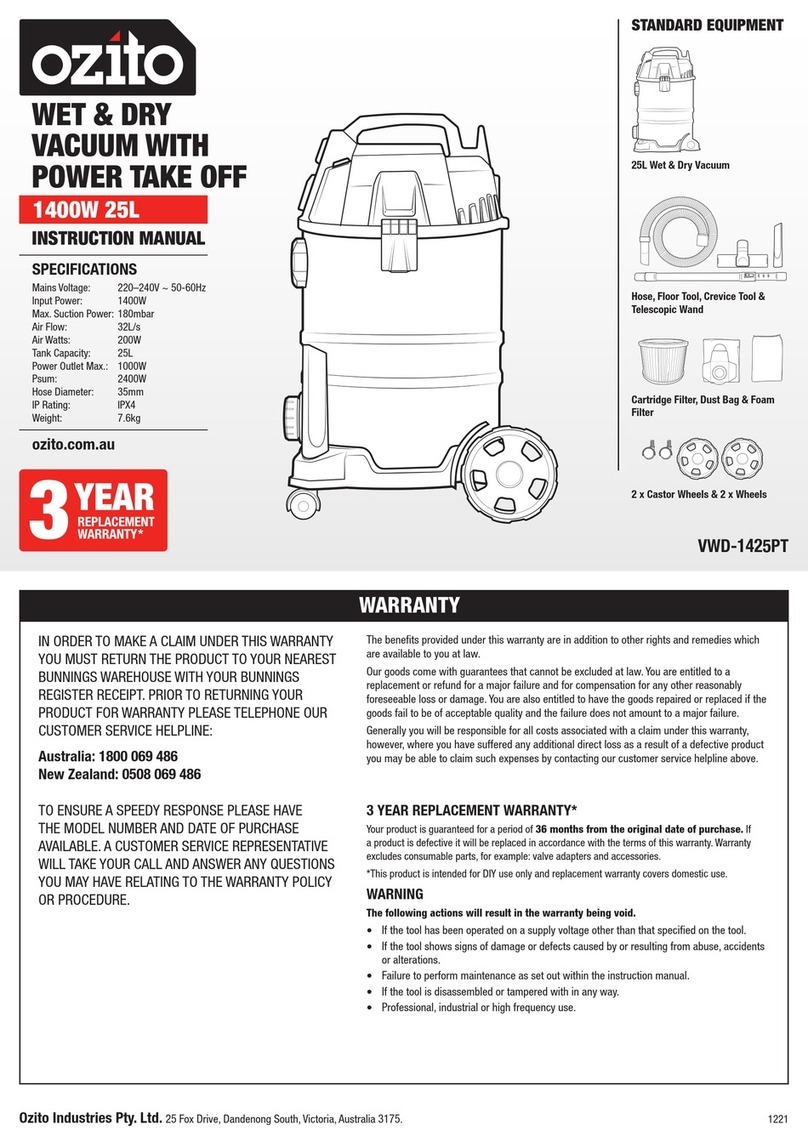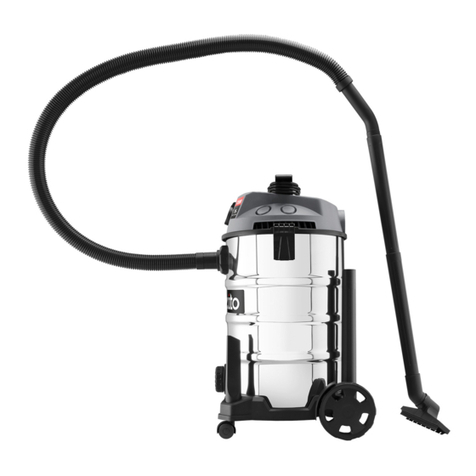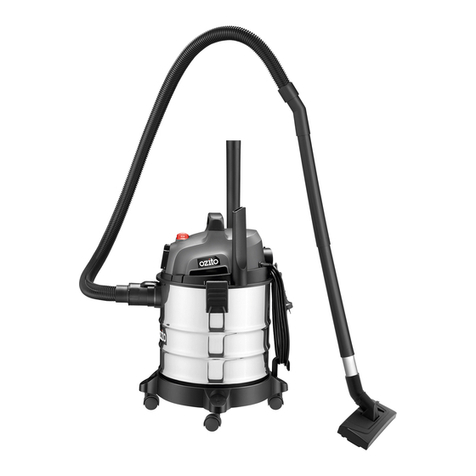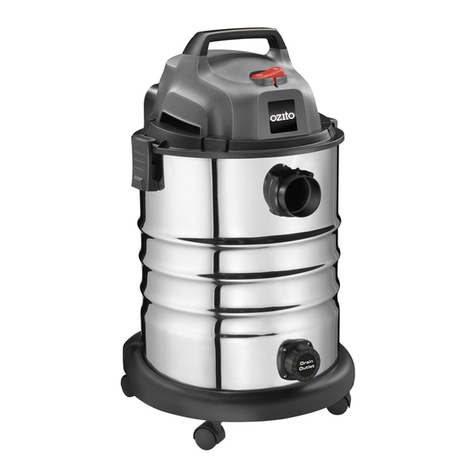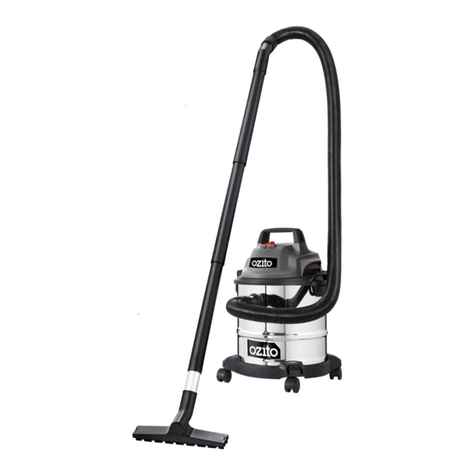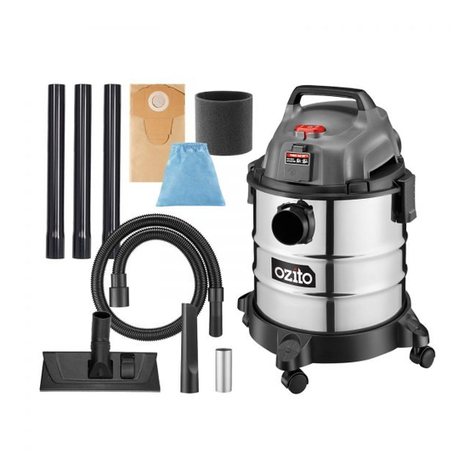
WARNING! When using mains-powered tools, basic safety precautions, including the
following, should always be followed to reduce risk of re, electric shock, personal injury and
material damage.
Read the whole manual carefully and make sure you know how to switch the tool o in an emergency,
before operating the tool.
Save these instructions and other documents supplied with this tool for future reference.
This tool is double insulated; therefore no earth wire is required.
Note: Double insulation does not take the place of normal safety precautions when operating
this tool. The insulation system is for added protection against injury resulting from a possible
electrical insulation failure within the tool.
If the supply cord is damaged, it must be replaced by a specially prepared cord available through the
service organisation.
Supply cords shall not be lighter than:
- if rubber insulated, ordinary tough rubber sheathed exible cord (code designation 60245 IEC 53);
- if polyvinyl chloride insulated, ordinary polyvinyl chloride sheathed exible cord (code designation 60227
IEC 53).
Using an Extension Lead
Always use an approved extension lead suitable for the power input of this tool. Before use, inspect the
extension lead for signs of damage, wear and ageing. Replace the extension lead if damaged or defective.
When using an extension lead on a reel, always unwind the lead completely. Use of an extension lead
not suitable for the power input of the tool or which is damaged or defective may result in a risk of re and
electric shock.
The power supply for this product should be protected by a residual current device (rated at 30mA or less).
A residual current device reduces the risk of electric shock.
WET & DRY VACUUM / BLOWER SAFETY WARNINGS
GENERAL POWER TOOL SAFETY WARNINGS
ELECTRICAL SAFETY
WARNING! Read all safety warnings and all instructions. Failure to follow the
warnings and instructions may result in electric shock, re and/or serious injury.
Save all warnings and instructions for future reference. The term “power tool” in the warnings
refers to your mains-operated (corded) power tool or battery-operated (cordless) power tool.
1. Work area safety
a. Keep work area clean and well lit. Cluttered or dark areas invite accidents.
b. Do not operate power tools in explosive atmospheres, such as in the presence of ammable
liquids, gases or dust. Power tools create sparks which may ignite the dust or fumes.
c. Keep children and bystanders away while operating a power tool. Distractions can cause you to
lose control.
2. Electrical safety
a. Power tool plugs must match the outlet. Never modify the plug in any way. Do not use any
adapter plugs with earthed (grounded) power tools. Unmodied plugs and matching outlets will
reduce risk of electric shock.
b. Avoid body contact with earthed or grounded surfaces, such as pipes, radiators, ranges and
refrigerators. There is an increased risk of electric shock if your body is earthed or grounded.
c. Do not expose power tools to rain or wet conditions. Water entering a power tool will increase the
risk of electric shock.
d. Do not abuse the cord. Never use the cord for carrying, pulling or unplugging the power tool.
Keep cord away from heat, oil, sharp edges or moving parts. Damaged or entangled cords increase
the risk of electric shock.
e. When operating a power tool outdoors, use an extension cord suitable for outdoor use. Use of a
cord suitable for outdoor use reduces the risk of electric shock.
3. Personal safety
a. Stay alert, watch what you are doing and use common sense when operating a power tool. Do
not use a power tool while you are tired or under the inuence of drugs, alcohol or medication. A
moment of inattention while operating power tools may result in serious personal injury.
b. Use personal protective equipment. Always wear eye protection. Protective equipment such as dust
mask, non-skid safety shoes, hard hat, or hearing protection used for appropriate conditions will reduce
personal injuries.
c. Prevent unintentional starting. Ensure the switch is in the o-position before connecting to
power source and/or battery pack, picking up or carrying the tool. Carrying power tools with your
nger on the switch or energising power tools that have the switch on invites accidents.
d. Remove any adjusting key or wrench before turning the power tool on. A wrench or a key left
attached to a rotating part of the power tool may result in personal injury.
e. Do not overreach. Keep proper footing and balance at all times. This enables better control of the
power tool in unexpected situations.
f. Dress properly. Do not wear loose clothing or jewellery. Keep your hair, clothing and gloves away
from moving parts. Loose clothes, jewellery or long hair can be caught in moving parts.
g. If devices are provided for the connection of dust extraction and collection facilities, ensure
these are connected and properly used. Use of dust collection can reduce dust-related hazards.
h. Do not let familiarity gained from frequent use of tools allow you to become complacent and
ignore tool safety principles. A careless action can cause severe injury within a fraction of a second.
4. Power tool use and care
a. Do not force the power tool. Use the correct power tool for your application. The correct power
tool will do the job better and safer at the rate for which it was designed.
b. Do not use the power tool if the switch does not turn it on and o. Any power tool that cannot be
controlled with the switch is dangerous and must be repaired.
c. Disconnect the plug from the power source and/or the battery pack from the power tool before
making any adjustments, changing accessories, or storing power tools. Such preventive safety
measures reduce the risk of starting the power tool accidentally.
d. Store idle power tools out of the reach of children and do not allow persons unfamiliar with the
power tool or these instructions to operate the power tool. Power tools are dangerous in the hands
of untrained users.
e. Maintain power tools. Check for misalignment or binding of moving parts, breakage of parts and any
other condition that may aect the power tool’s operation. If damaged, have the power tool repaired
before use. Many accidents are caused by poorly maintained power tools.
f. Keep cutting tools sharp and clean. Properly maintained cutting tools with sharp cutting edges are
less likely to bind and are easier to control.
g. Use the power tool, accessories and tool bits etc. in accordance with these instructions, taking
into account the working conditions and the work to be performed. Use of the power tool for
operations dierent from those intended could result in a hazardous situation.
h. Keep handles and grasping surfaces dry, clean and free from oil and grease. Slippery handles and
grasping surfaces do not allow for safe handling and control of the tool in unexpected situations.
5. Service
a. Have your power tool serviced by a qualied repair person using only identical replacement
parts. This will ensure that the safety of the power tool is maintained.
WARNING! The appliance is not to be used by persons (including children) with
reduced physical, sensory or mental capabilities, or lack of experience and knowledge,
unless they have been given supervision or instruction.
Young children should be supervised to ensure that they do not play with the appliance.
When using the equipment, a few safety precautions must be observed to avoid injuries and damage.
Please read the complete operating manual with due care. Keep this manual in a safe place so that
the information is available at all times. If you give the equipment to any other person, give them these
operating instructions as well.
We cannot accept any liability for damage or accidents which arise due to a failure to follow these
instructions and the safety information.
The equipment is to be used only for its prescribed purpose. Any other use is deemed to be a case
of misuse. The user / operator and not the manufacturer will be liable for any damage or injuries of
any kind caused as a result of this.
• Read the instructions carefully. Be familiar with the controls and the proper use of the appliance.
• Switch o and remove plug from mains before cleaning or maintenance.
• Do not use in the rain or leave outdoors while it is raining.
• Keep bystanders away.
• Never allow children to use the appliance
• Never allow people unfamiliar with these instructions to use the appliance. Local regulations may
restrict the age of the operator
• The operator or user is responsible for accidents or hazards occurring to other people or their property
• Always wear adequate protective clothing when operating the tool to avoid injuries to face, eyes, hand,
feet, head or hearing. Use safety glasses or a face shield, high boots or sturdy shoes, long trousers,
work gloves, a hard hat and ear defenders.
• Do not start the tool when it is upside down or when it is not in the operating position.
• Ensure that the extension lead is secured in a manner that prevents it from disconnecting from the
plug whilst in use.
• Keep all the air intakes and the blower tube free of dust, lint, hair and other material that may cause a
reduction in air ow.
• Do not place blower on oor or other surfaces whilst still operating, the air intake can suck up and blow
out dust and rocks
• To avoid electric shock, do not expose to rain. Store indoors.
• Never use in the presence of explosive liquids, vapours or explosive dust – such as coal
or grain.
• Never operate the appliance while people, especially children, or pets are nearby.
• While operating the appliance, always wear substantial footwear and long trousers.
• Do not wear loose clothing or jewellery that can be drawn into the air inlet. Keep long hair away from
the air inlets.
• Wear protective goggles while operating the unit.
• To prevent dust irritation, the wearing of a face mask is recommended.
• Before using, check the supply and extension cord for signs of damage and aging. Do not use the
appliance if the cord is damaged or worn.
• Never operate the appliance with defective guards or shields, or without safety devices, for example
debris collector in place.
• Do not use cleaner without the lter in place.
• Only use a weather proof extension cable tted with a coupler according to IEC 60320-2-3.
• Always direct the power cord to the rear away from the appliance.
• If a cord becomes damaged during use, disconnect the supply cord from the mains immediately. DO
NOT TOUCH THE CORD BEFORE DISCONNECTING THE SUPPLY.
• Do not carry the appliance by the cable.
• When lifting the unit, always lift it with the handle or under rim of bucket. Beware of excess weight.
• The wet and dry vacuum cleaner is designed for wet and dry vacuuming using the appropriate
lter. The appliance is not suitable for the vacuuming of combustible, explosive or harmful
substances.
• Never pick up or blow asbestos or asbestos dust.
• Wood dust and chips in a conned area can give rise to re or an explosion. Guard against possible
ignition sources.
• Do not pick up anything that is burning or smouldering – such as metal grinding dust, cigarette ends,
hot coals, matches or similar.
• Disconnect the appliance from the mains supply
- whenever you leave the machine;
- before clearing a blockage;
- before checking, cleaning or working on the appliance
- if the appliance starts to vibrate abnormally.
• Always switch the unit o before changing attachments or connecting dierent power tools.
• Operate the appliance only in daylight or in good articial light.
• Do not overreach and keep your balance at all times.
• Always be sure of your footing on slopes.
• Walk, never run.
• Never blow debris in the direction of bystanders.
• Keep all nuts, bolts and screws tight to be sure the appliance is in safe working condition.
• Check the debris collector frequently for wear or deterioration.
• Keep all cooling air inlets clear of debris.
• Always check that the lter is clear and not blocked. Keep all openings clear of any blockages.
• If motor sound becomes higher pitched always check for the following:
- Blocked hose or accessory.
- Blocked lter.
- Full container.
• Replace worn or damaged parts.
• Use only genuine replacement parts and accessories.
• Never modify the cleaner in any way - this is dangerous and will invalidate the warranty.
• Store the appliance only in a dry place.


